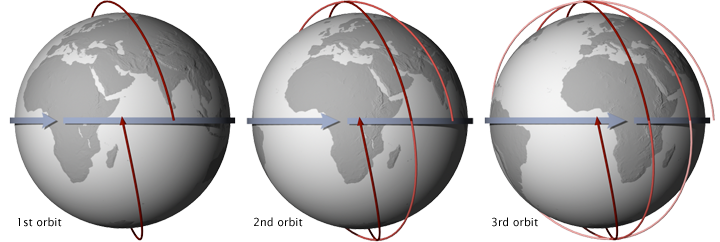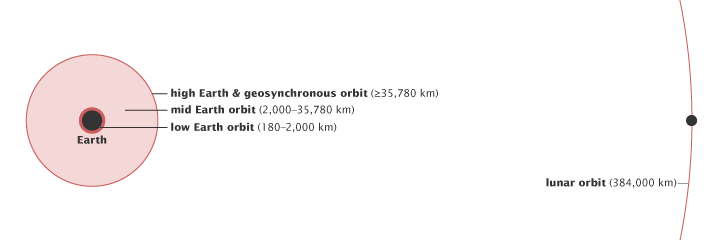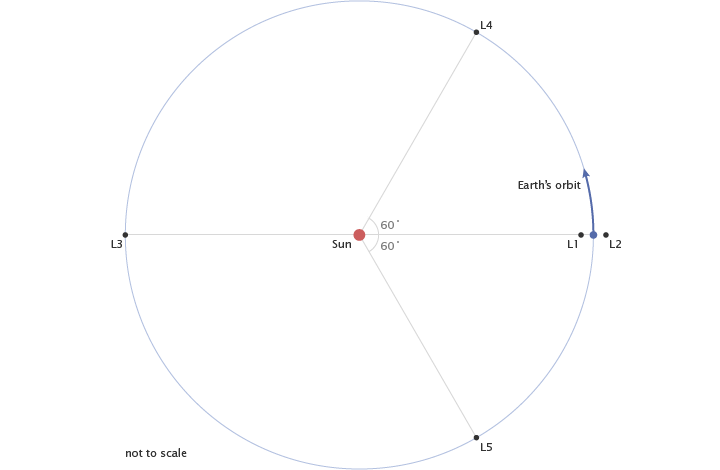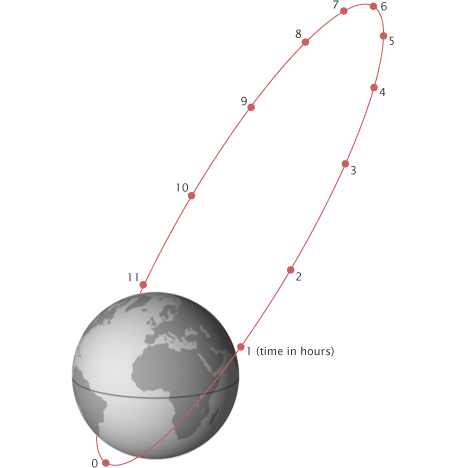Science & Technology
Types of Orbit
- 22 Jun 2020
- 12 min read
An orbit is a regular, repeating path that an object in space takes around another one. An object moving around a planet in an orbit is called a satellite. According to the height of satellites from the earth, the orbits can be classified as High Earth orbit, Medium Earth orbit, and Low Earth orbit.
- High Earth orbit begins about one-tenth of the way to the moon. Many kinds of weather and some communications satellites tend to have a high Earth orbit, furthest away from the surface.
- Satellites that orbit in a medium (mid) Earth orbit include navigation satellites, designed to monitor a particular region.
- Most scientific satellites, including NASA’s Earth Observing System fleet, have a low Earth orbit.
Path of a Satellite in an Orbit
Together, the satellite’s height, eccentricity, and inclination determine the satellite’s path in an orbit.
Height of Satellite
- The height of the orbit, or distance between the satellite and Earth’s surface, determines how quickly the satellite moves around the Earth. Higher a satellite’s orbit, the slower it moves.
- An Earth-orbiting satellite’s motion is mostly controlled by Earth’s gravity. As satellites get closer to Earth, the pull of gravity gets stronger, and the satellite moves more quickly.
- For Example, NASA’s Aqua satellite requires about 99 minutes to orbit the Earth at about 705 kilometres height from Earth’s surface.
- A communication satellite about 36,000 kilometres from Earth’s surface takes 23 hours, 56 minutes, and 4 seconds to complete an orbit.
- At 384,403 kilometres from the centre of the Earth, the Moon completes a single orbit in 28 days.
- Changing a satellite’s height will also change its orbital speed, which represents a strange paradox.
- If a satellite operator wants to increase the satellite’s orbital speed, he can’t simply fire the thrusters to accelerate the satellite. Doing so would boost the orbit (increase the altitude), which would slow the orbital speed.
- Instead, he must fire the thrusters in a direction opposite to the satellite’s forward motion. This change will push the satellite into a lower orbit, which will increase its forward velocity.
- The same action that on the ground would slow a moving vehicle.
Eccentricity of Orbit
- Eccentricity refers to the shape of the orbit. A satellite with a low eccentricity orbit moves in a near circle around the Earth.
- An eccentric orbit is elliptical, with the satellite’s distance from Earth changing depending on where it is in its orbit.
Note:
- The eccentricity (e) of an orbit indicates the deviation of the orbit from a perfect circle.
- A circular orbit has an eccentricity of 0, while a highly eccentric orbit is closer to (but always less than) 1.
- A satellite in an eccentric orbit moves around one of the ellipse’s focal points, not the centre.
Inclination of Orbit
- The inclination is the angle of the orbit in relation to Earth’s equator.
- An orbital inclination of 0° is directly above the equator, 90° crosses right above the pole, and 180° orbits above the equator in the opposite direction of Earth’s spin.
High Earth Orbit
- High Earth Orbit is when a satellite reaches exactly 42,164 kilometres from the centre of the Earth (about 36,000 kilometres from Earth’s surface).
- At this altitude, the satellite enters a sort of “sweet spot” in which its orbit matches Earth’s rotation. This special, high Earth orbit is called geosynchronous.
- A satellite in a circular geosynchronous orbit directly over the equator (eccentricity and inclination at zero) will have a geostationary orbit that does not move at all relative to the ground.
- This is because the satellite orbits at the same speed that the Earth is turning, it is always directly over the same place on the Earth’s surface.
- Use of a geostationary orbit is extremely valuable for weather monitoring and communication (phones, television, radio) because satellites in this orbit provide a constant view of the same surface.
- Finally, many high Earth-orbiting satellites monitor solar activity, track magnetic and radiation levels in space around them.
Note:
- Other orbital “sweet spots,” just beyond high Earth orbit, are the Lagrange points.
- At the Lagrange points, the pull of gravity from the Earth cancels out the pull of gravity from the Sun.
- Anything placed at these points will feel equally pulled toward the Earth and the Sun and will revolve with the Earth around the Sun.
Lagrange Points
- The first Lagrange point is located between the Earth and the Sun, giving satellites at this point a constant view of the Sun.
- The Solar and Heliospheric Observatory (SOHO), a NASA and European Space Agency satellite tasked to monitor the Sun, orbits the first Lagrange point, about 1.5 million kilometres away from Earth.
- The second Lagrange point is about the same distance from the Earth but is located behind the Earth. Earth is always between the second Lagrange point and the Sun.
- Since the Sun and Earth are in a single line, satellites at this location only need one heat shield to block heat and light from the Sun and Earth.
- It is a good location for space telescopes, including the future James Webb Space Telescope.
- The third Lagrange point is opposite the Earth on the other side of the Sun so that the Sun is always between it and Earth.
- A satellite in this position would not be able to communicate with Earth.
- The extremely stable fourth and fifth Lagrange points are in Earth’s orbital path around the Sun, 60 degrees ahead of and behind Earth.
- The twin Solar Terrestrial Relations Observatory (STEREO) spacecraft will orbit at the fourth and fifth Lagrange points to provide a three-dimensional view of the Sun.
Medium Earth Orbit
Closer to the Earth, satellites in a medium Earth orbit move more quickly. Two medium Earth orbits are notable: the semi-synchronous orbit and the Molniya orbit.
- Semi-synchronous orbit is a near-circular orbit (low eccentricity) 26,560 kilometres from the centre of the Earth (about 20,200 kilometres above the surface).
- A satellite at this height takes 12 hours to complete an orbit.
- In 24-hours, the satellite crosses over the same two spots on the equator every day. This orbit is consistent and highly predictable.
- It is the orbit used by the Global Positioning System (GPS) satellites.
- Molniya orbit is the second common medium Earth orbit.
- It was invented by the Russians, the Molniya orbit works well for observing high latitudes.
- Molniya orbit offers a useful alternative to geostationary orbit, as satellites in a geostationary orbit are parked over the equator, so they don’t work well for far northern or southern locations, which are always on the edge of view of geostationary satellites.
- The Molniya orbit combines high inclination (63.4°) with high eccentricity (0.722) to maximize viewing time over high latitudes.
- Each orbit lasts 12 hours, so the slow, high-altitude portion of the orbit repeats over the same location every day and night. Russian communications satellites and the Sirius radio satellites currently use this type of orbit.
Molniya Orbit
Low Earth Orbit
- Most scientific satellites and many weather satellites are in a nearly circular, low Earth orbit.
- The satellite’s inclination depends on what the satellite was launched to monitor.
- The Tropical Rainfall Measuring Mission (TRMM) satellite was launched to monitor rainfall in the tropics. Therefore, it has a relatively low inclination (35 degrees), staying near the equator.
- Many of the satellites in NASA’s Earth Observing System have a nearly polar orbit.
- In this highly inclined orbit, the satellite moves around the Earth from pole to pole, taking about 99 minutes to complete an orbit.
- In a 24-hour period, polar-orbiting satellites will view most of the Earth twice: once in daylight and once in darkness.
- As the satellite completes one orbit, the Earth turns underneath, so by the time the satellite crosses back into daylight, it is over the region adjacent to the area seen in its last orbit.

Path of a Polar Orbit
- Just as the geosynchronous satellites have a sweet spot over the equator that lets them stay over one spot on Earth, the polar-orbiting satellites have a sweet spot that allows them to stay in one time.
- This orbit is a Sun-synchronous orbit, which means that whenever and wherever the satellite crosses the equator, the local solar time on the ground is always the same.
- For example, if a polar satellite at 10:30 in the morning crosses the equator in Brazil when the satellite comes around the Earth in its next overpass about 99 minutes later, it crosses over the equator in Ecuador or Colombia at about 10:30 local time.
For Mindmaps follow our Youtube Channel









